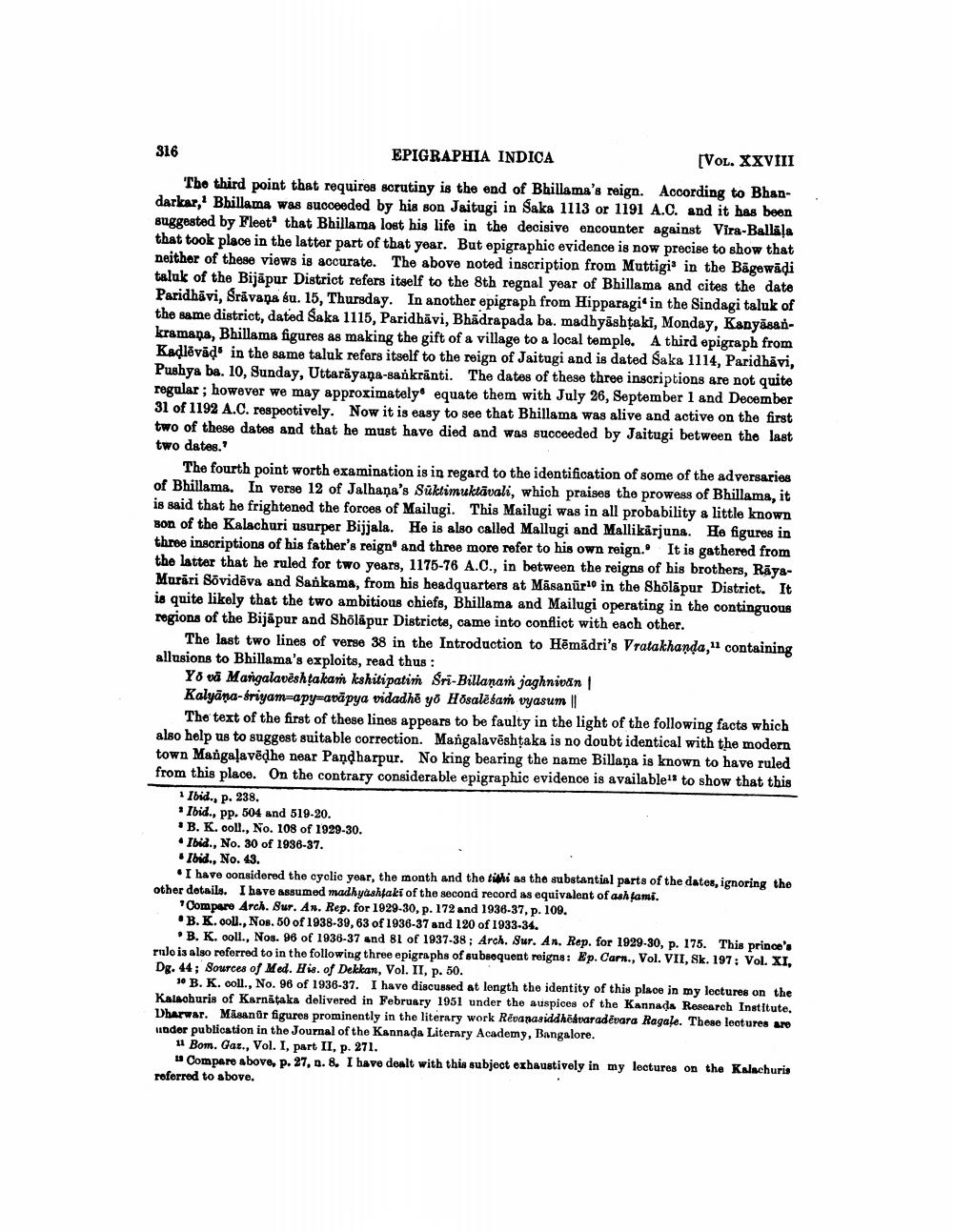________________
316
EPIGRAPHIA INDICA
[VOL. XXVIII
The third point that requires scrutiny is the end of Bhillama's reign. According to Bhandarkar, Bhillama was succeeded by his son Jaitugi in Saka 1113 or 1191 A.C. and it has been suggested by Fleet' that Bhillama lost his life in the decisive encounter against Vira-Ballāļa that took place in the latter part of that year. But epigraphic evidence is now precise to show that neither of these views is accurate. The above noted inscription from Muttigi3 in the Bägewādi taluk of the Bijapur District refers itself to the 8th regnal year of Bhillama and cites the date Paridhavi, Sravana su. 15, Thursday. In another epigraph from Hipparagi' in the Sindagi taluk of the same district, dated Saka 1115, Paridhavi, Bhadrapada ba. madhyashṭaki, Monday, Kanyasankramana, Bhillama figures as making the gift of a village to a local temple. A third epigraph from Kadlevad in the same taluk refers itself to the reign of Jaitugi and is dated Saka 1114, Paridhavi, Pushya ba. 10, Sunday, Uttarayana-sankranti. The dates of these three inscriptions are not quite regular; however we may approximately equate them with July 26, September 1 and December 31 of 1192 A.C. respectively. Now it is easy to see that Bhillama was alive and active on the first two of these dates and that he must have died and was succeeded by Jaitugi between the last two dates."
The fourth point worth examination is in regard to the identification of some of the adversaries of Bhillama. In verse 12 of Jalhana's Suktimuktavali, which praises the prowess of Bhillama, it is said that he frightened the forces of Mailugi. This Mailugi was in all probability a little known son of the Kalachuri usurper Bijjala. He is also called Mallugi and Mallikarjuns. He figures in three inscriptions of his father's reign and three more refer to his own reign. It is gathered from the latter that he ruled for two years, 1175-76 A.C., in between the reigns of his brothers, RayaMurari Sōvidēva and Sankama, from his headquarters at Masanür10 in the Shōlapur District. It is quite likely that the two ambitious chiefs, Bhillama and Mailugi operating in the continguous regions of the Bijapur and Shōlapur Districts, came into conflict with each other.
The last two lines of verse 38 in the Introduction to Hemadri's Vratakhanda," containing allusions to Bhillama's exploits, read thus:
Yo va Mangalaveshtakam kshitipatim Sri-Billanam jaghnivan | Kalyana-sriyam-apy-avapya vidadhe yō Hōsalesaṁ vyasum ||
The text of the first of these lines appears to be faulty in the light of the following facts which also help us to suggest suitable correction. Mangalaveshṭaka is no doubt identical with the modern town Mangalaveḍhe near Pandharpur. No king bearing the name Billana is known to have ruled from this place. On the contrary considerable epigraphic evidence is available to show that this
1 Ibid., p. 238.
Ibid., pp. 504 and 519-20.
B. K. coll., No. 108 of 1929-30.
Ibid., No. 30 of 1936-37.
Ibid., No. 43.
⚫ I have considered the cyclic year, the month and the tithi as the substantial parts of the dates, ignoring the other details. I have assumed madhyashtaki of the second record as equivalent of ash tami.
"Compare Arch. Sur. An. Rep. for 1929-30, p. 172 and 1936-37, p. 109.
B. K. ooll., Nos. 50 of 1938-39, 63 of 1936-37 and 120 of 1933-34.
B. K. coll., Nos. 96 of 1936-37 and 81 of 1937-38; Arch. Sur. An. Rep. for 1929-30, p. 175. This prince's rulo is also referred to in the following three epigraphs of subsequent reigns: Ep. Carn., Vol. VII, Sk. 197: Vol. XI, Dg. 44; Sources of Med. His. of Dekkan, Vol. II, p. 50.
10 B. K. coll., No. 96 of 1936-37. I have discussed at length the identity of this place in my lectures on the Kalachuris of Karnataka delivered in February 1951 under the auspices of the Kannada Research Institute. Dharwar. Mäsanür figures prominently in the literary work Revanasiddhëávaradevara Ragale. These lectures are under publication in the Journal of the Kannada Literary Academy, Bangalore.
11 Bom. Gaz., Vol. I, part II, p. 271.
Compare above, p. 27, n. 8. I have dealt with this subject exhaustively in my lectures on the Kalachuris referred to above.




